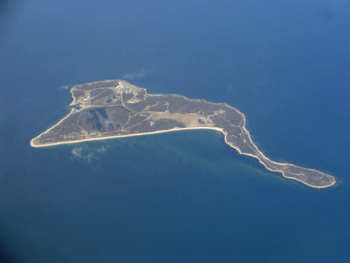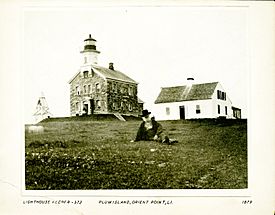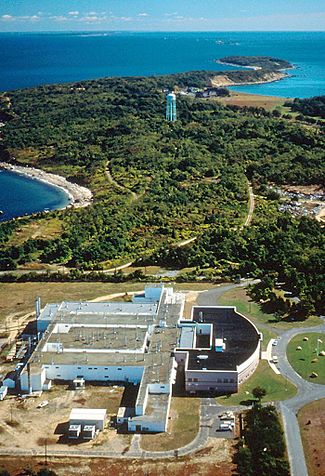Plum Island (New York) facts for kids
|
Native name:
Manittuwond
|
|
|---|---|
 |
|
|
Plum Island (New York)
|
|
| Geography | |
| Location | Block Island Sound/Long Island Sound |
| Coordinates | 41°10′59″N 72°11′25″W / 41.18306°N 72.19028°W |
| Total islands | 1 |
| Area | 840 acres (340 ha) |
| Length | 3 mi (5 km) |
| Width | 1 mi (2 km) |
| Administration | |
| State | New York |
| County | Suffolk |
Plum Island is an island in the town of Southold in Suffolk County, New York, in the United States. The island is situated in Gardiners Bay, east of Orient Point, off the eastern end of the North Fork coast of Long Island. It is about 3 miles (4.8 km) long and 1 mile (1.6 km) wide at its widest point.
The island is the site of the Plum Island Animal Disease Center (PIADC), which was established by the United States Department of Agriculture (USDA) in 1954. The Island is also the site of the former U.S. military installation Fort Terry (c. 1897), and the historic Plum Island Light (c. 1869), and its automated replacement.
Plum Island is owned in its entirety by the United States government, which was considering sale of the island, but suspended the plan in February 2012. Access to the island is controlled by the United States Department of Homeland Security (DHS).
On August 29, 2013, the United States General Services Administration (GSA) and United States Department of Homeland Security (DHS) announced a final "Record of Decision (ROD): Public Sale of Plum Island, New York".
After years of pressure from organizations including the Preserve Plum Island Coalition (PPIC), the Connecticut Fund for the Environment, along with its permanent regional program Save the Sound and Soundkeeper, Inc., Congress voted in December 2020 to block the sale and preserve Plum Island. In 2020, President Donald Trump signed the legislation.
Geology
The northern portion of Plum Island is a recessional moraine deposit, and is part of the Harbor Hill-Roanoke Point-Fishers Island-Charlestown Moraine, thus is one of the Outer Lands. Boulders in the moraine can be seen in the eroding northern slope of the island.
History

Plum Island was called "Manittuwond" by the Native American Pequot Nation. Plum Island was probably first seen by Europeans in 1614 when Adriaen Block, a Dutchman employed by the Dutch West India Company, charted the area. The Island was named from the beach plums that grow along the shores, and an old Dutch map made about 1640 shows the name "Pruym Eyelant" (Plum Island). In 1659, the Island was purchased by Samuel Wyllys III (Samuel Willis III), son of the Governor of Connecticut, from Wyandanch, the ruling local Indian Chieftain of Long Island, for a coat, a barrel of biscuits and 100 fishhooks.
On August 11, 1775, General David Wooster dispatched 120 soldiers to the island, then known as Plumb Island, who were immediately fired upon by the British. After firing a single return volley the soldiers retreated back to Long Island. Although no casualties were reported, this brief skirmish is believed to have represented at least one American military first, the first amphibious assault by an American army.
The historic Plum Island Lighthouse is located at the west end of the island. The original lighthouse on Plum Island was constructed in 1827; the current structure was built in 1869. The light marks the east side of "Plum Gut", a mile-wide entrance to Long Island Sound with extremely strong tidal currents. The light aided navigation near the entrance to Long Island Sound, especially through the "Plum Gut" channel between Orient Point and Plum Island.
After passing through the possession of more than twenty families, in 1899, the Island was purchased in its entirety by the United States Government, following the Spanish–American War, for approximately $90,000. The U.S. Army established a Coast Artillery post, later known as Fort Terry, on the Island, in 1897. During World War II the Fort was activated as an anti-submarine base and deactivated after World War II. The Fort was later reactivated and assigned to the Army Chemical Corps.
In 1954 the United States Department of Agriculture (USDA) established the Plum Island Animal Disease Center (PIADC). The Center conducts research on animal pathogens to protect farmers, ranchers, and the national food supply. Because of the nature of the research, access to the Island and the research facility is restricted.
In 2003, the United States Department of Homeland Security (DHS) assumed ownership of the Island and all its facilities. The USDA continues its long running science mission at PIADC jointly with DHS, who are charged with the safe and secure operation of the facility.
As one result of the heightened national security initiatives following the attacks on the United States on September 11, 2001, Plum Island was considered as a potential site for a new high-security animal disease lab, National Bio and Agro-Defense Facility (NBAF). In September 2008, the U.S. Congress passed Public Law 110-329 (Sec. 540 - New York) that directed the General Services Administration (GSA) to close the PIADC, sell the Island to the public, and to use the proceeds towards the construction of the NBAF, if it were decided that NBAF would be built elsewhere. In January 2009, the United States Department of Homeland Security (DHS) selected the City of Manhattan, Kansas, as the site for the NBAF, and decided to relocate the PIADC there as well. However, the decline in real estate values stemming from the subprime mortgage crisis and late-2000s recession caused the sale of the Island to be considered no longer viable. Because the proceeds from selling the Island were needed to construct the new facility in Kansas, the project was effectively cancelled for the short term when the 2013 federal budget request contained no funding for the new facility. As part of the planned sale of Plum Island, the United States Government has been preparing an Environmental Impact Statement (EIS) for the Island, one objective of which is to determine whether the impact of nearly sixty years of animal testing on the Island constitutes a threat to public health that could preclude the planned sale.
Book Documenting History
In June 2012, the Southold Historical Society announced that it planned to publish a detailed history of Plum Island from the period of colonial settlement through modern times. The book, according to the Society, would correct a number of errors and mistakes in previous historical examinations, and provide the first complete, annotated history of the Island to date. The Society stated further that it was currently looking for original documents and images relating to the historic structures and families that once occupied Plum Island.
In September 2014, the Southold Historical Society announced the publication of the new book "A World Unto Itself: The Remarkable History of Plum Island, New York" documenting the history of Plum Island from its creation to the present day. Among the topics covered is the Island's use by British forces during the American Revolutionary War and the War of 1812, the Island's use as a place of recreation during the "Leisure Age," as well as serving as the location of the 1914 court martial of Benjamin M. Koehler, whose conviction on charges of homosexuality eventually led to the policy of Don't ask, don't tell. The Society noted in its press release regarding the release of the book:
"Through its many incarnations, Plum Island has managed to remain in a semi-natural state. Today, it provides a rare glimpse of what Long Island and much of the Northeast was like before it was gripped by progress. At the same time, it bears the marks of the human history that has unfolded there: the lighthouse tended by so many stalwarts; the narrow roads, rusted railroad tracks and overgrown artillery batteries once filled with soldiers who never saw combat; and, of course, the modern-day facility where the daily pursuit of science both moves us forward and pushes us away."
In popular culture
- The 1988 novel The Silence of the Lambs by author Thomas Harris mentions "Plum Island" as a potential supervised vacation site for Hannibal Lecter as a reward for helping to catch Jame Gumb. He derisively refers to it as "Anthrax Island." It is also used in this way in the movie adaptation of the novel.
- Plum Island is a 1997 novel by Long Island, New York author Nelson DeMille, who uses the Island as one of his settings in the book.
- The 2004 book Lab 257: The Disturbing Story of the Government's Secret Plum Island Germ Laboratory by Michael Carroll, Ph.D., examines the Plum Island Animal Disease Center (PIADC).
- Plum Island is the title and focus of one episode of the television series Conspiracy Theory with Jesse Ventura. The episode was originally broadcast on Oct. 15, 2010, in Season Two.
- Plum Island is theorized by some to be the origin of the monster in the 2008 movie Cloverfield.
- Plum Island is referred to in Season 4, Episode 4, "Dawn of the Med", of the show Royal Pains.
- Plum Island is the location of a deadly government conspiracy in the 2014 novel, The Montauk Monster by Hunter Shea.
- Plum Island is the location of the Advanced Neurotechnologies Laboratory (ANS) in the 2016 novel, Game Changer by Douglas E. Richards
- Plum Island is the location of the US government's main research facility trying to stop the Hemorrhage Virus in the post-apocalyptic Extinction Cycle series by Nicholas Sansbury Smith.
- "Plum Island" is a song by the band Waterparks featured on their album, Double Dare.
See also
 In Spanish: Isla Plum (Nueva York) para niños
In Spanish: Isla Plum (Nueva York) para niños



